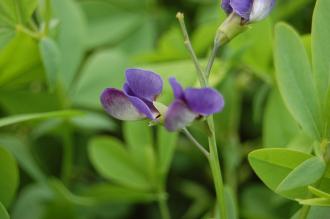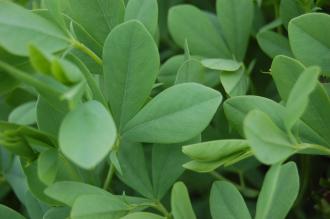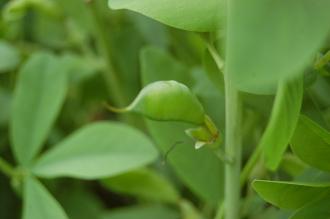
Baptisia australis (02/07/2016, Kew Gardens, London)
Position: Full sun to partial shade
Flowering period: Early summer
Soil: Moist, well drained
Eventual Height: 1.5m
Eventual Spread: 1m
Hardiness: 3b, 4a, 4b, 5a, 5b, 6a, 6b, 7a, 7b, 8a, 8b, 9a
Family: Papilionaceae or Fabaceae

Baptisia australis Flower (02/07/2016, Kew Gardens, London)
Baptisia australis is a deciduous shrubby perennial with a clump forming habit. Its green/ gray leaves are trifoliate. Its leaflets are ovate with entire margins. Its violet flowers are up to 25mm long and appear as terminal erect racemes which are up to 20cm long and above its leaves. Its dark gray fruit are cylindrical bean like pods and up to 6cm long. Its roots contain rhizomes and if left undisturbed this plant will form a tap root.
Baptisia australis, commonly known as False Indigo, Blue Wild Indigo or Bastard Lupine, is native to central and east North America. All parts of this plant are toxic if ingested. In its native habitat it grows at woodland margins and open meadows.

Baptisia australis Leaf (02/07/2016, Kew Gardens, London)
The etymological root of the binomial name Baptisia is derived from the Greek baptos meaning ‘dyed’, in reference to its historic use as a dye. Australis is from the Latin meaning ‘southern’.
The landscape architect may find Baptisia australis useful as a free flowering perennial. Once established this plant is drought tollerant. This plant may open up after flowering, staking may be used to help prevent this.

Baptisia australis Seed Pod (02/07/2016, Kew Gardens, London)
Ecologically, Baptisia australis flowers are attractive to pollinating insects, including butterflies.
The Royal Horticultural Society have given Baptisia australis their prestigious Award of Garden Merit in 1993.
Baptisia australis prefers moist, fertile, well-drained soils. It tolerates most pH of soil, although it prefers a slightly acid soil. It will tolerate poor soils.
Baptisia australis requires little maintenance. Large clumps may be dived every 4 to 5 years.

Landscape Architecture

